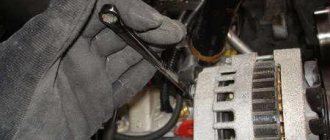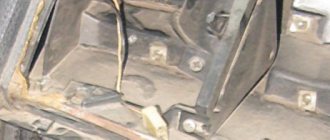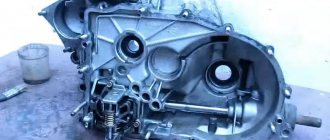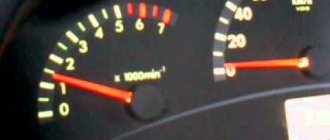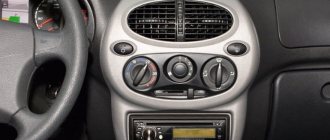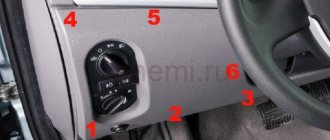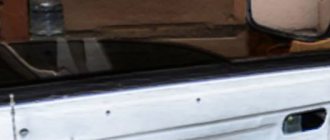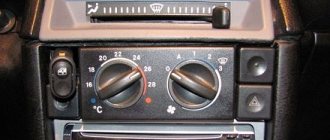The noise of the stove on a Priora is a phenomenon that many owners of this car encounter sooner or later. Moreover, even representatives of the manufacturing plant noted in 2008 that a similar situation is possible on cars with a climate system developed by Panasonic. Service centers were recommended to eliminate inconsistencies in the form of a whistle or hum by installing an additional gasket. However, in situations where the stove on the Priora is noisy, a visit to the service center is not at all necessary.
Lada.Online | Topic author: Wakana
What to do if the stove is noisy on a Lada Priora
The article is devoted to another problem that many Lada Priora owners face.
A familiar situation is when the stove fan hums, whistles, howls or makes a hum. There may be several reasons for the malfunction, we will tell you about each of them in detail. Back in 2009, AvtoVAZ published an information letter that described the situation with noise in the form of a whistling fan of the Panasonic climate system. The reason was that the damper did not fit tightly.
To eliminate the noise of the stove, it is necessary to modify the heater design by installing an additional seal on the damper, using Splen with dimensions of 8x10x100 mm.
Extraneous noise from the Priora stove fan can also be associated with strong play in the axis on which it is installed. To eliminate it, you should disassemble the fan and install an additional washer at the bottom. When assembling, lubricate the rubbing parts with lubricant. It often happens that the stove makes noise only when it is cold, and when the interior warms up, the whistle disappears. Try lubricating the motor rotor bushing. There are two options, either disassemble the heater and fan, or remove only the frill (wind cover) and drill on the side in the place as indicated in the photo.
You will need a drill with a diameter of 3 mm and a length of 15-20 cm.
Pour synthetic oil into the resulting hole using a syringe. Upon completion of work, close the hole with suitable material. A rustling sound when the stove is operating may occur due to foreign objects getting into the fan blades, for example, a dry leaf. You can remove it through the glove compartment.
If no method helps solve the problem of stove noise, the parts may simply have worn out their service life (bushings, bearings, etc.) and should be replaced with new ones, or a new stove fan assembly should be installed. Have you encountered similar whistling and howling? How did you solve the problem? Let us remind you that this is not the only drawback that the car received from the factory. The source of extraneous noise may be the gearbox.
https://lada.online/do-my-self/tuning/tuning-lada-priora/692-chto-delat-esli-shumit-pechka-na-lada-priora.html What to do if the stove is noisy on a Lada Priora Article is dedicated to another problem that many Lada Priora owners face. A familiar situation is when the stove fan hums and whistles. lada.online
Tags: How to remove the heater fan on a Priora without air conditioning
What should you do if the heating in your Lada Priora car is not working properly?
Often Russian car enthusiasts who drive a Lada Priora complain that the heater is not working well, the vehicle interior is cool, and the car’s side and windshield windows are freezing. In order to understand why the stove on the Priora stopped working, let’s look at the design of the entire heating system on cars of this modification.
The vehicle is equipped with a stove (heating system) with a climate control system that provides comfort while traveling in the car. They are designed to eliminate problems in the event of cold weather or other weather changes. No one will ask the question why the stove in the Priora does not work, neither the driver nor the passengers.
The car's climate control system includes:
- the stove itself (heater);
- stove fan device;
- temperature sensor in the cabin;
- air distributor housing;
- airways;
- deflectors (directing the flow of air masses).
The air flow from the stove is transmitted to the housing part of the air distributor, from where it is directed along air lines.
Through the air ducts, the flow flows to the windshield grilles of the windshield and side windows, to the air mass flow guides in the center and side of the dashboard, as well as to the lower plane of the cabin to the floor pans on the bottom of the body.
With the advent of frost, defects in the heating system appear, the most unpleasant of which is that the Lada Priora stove does not work and other malfunctions.
In a Lada Priora car, the heater regulator does not work due to a malfunction of the multi-position switch or a defect in the blower fan.
When troubleshooting this problem, when the Priora stove fan does not work, you should look at the fuse box, which is the main source of trouble for the operation of the ventilation device.
Many defects in a car's climate system are directly related to the operation of the vehicle's cooling system.
If the fan device is in good working order, but the stove on the Priora does not heat well, then the defect should be looked for by a sequential method of cutting off the tested elements. So, the stove on the Priora is not working well and the interior is quite cool:
First stage : with the engine brought to the optimal temperature, we check the 2 pipes connected to the heater for temperature values.
If both products are hot, then there is no circulation of air masses, and if one pipe is hot and the other is cold, then this indicates a lack of circulation of the aqueous solution in the system.
We carry out diagnostics of the heater tap in order to deal with the cooling system solution (water, antifreeze).
For this purpose, open the hood and move the tap from one position to another. If there is a leak from the heating system, then it must be eliminated, because...
an insufficient amount of coolant can provoke a situation where cold air blows from the Priora’s stove and the cabin becomes cool.
If the tap is rusty and cannot be adjusted, you can leave it in this position during the summer when the heating system is not in use. Closer to cold weather it needs to be replaced.
Second stage : when the faucet is in the working position and the stove refuses to work, remove the filler plug of the radiator tank and check for the presence of coolant fluid. In case of formation of the so-called
“plugs from the air”, we bring the coolant level to the maximum value (sometimes it happens that in a Priora cold air blows from the stove due to a lack of coolant).
After this, we turn on the power plant and sharply press the accelerator pedal several times, which will provoke a coolant circulation and, under its influence, the water pump will squeeze out the air layer plug.
In order for the air masses to move faster to the output level, it is necessary to drive onto an elevation so that the radiator is lower than the radiator of the cooling system. So, cooler circulation has been restored, 2 pipes have become hot, but the stove on the Priora still doesn’t work well?
Third stage : the dampers may not be working, because an open lever on the instrument panel does not mean at all that the dampers have duplicated this command. Failure of the dampers may be associated with loosening of the fastenings of the heater rods and taps, which blocks them in summer mode.
With the hood open, it wouldn’t hurt to check whether the Priora’s heater dampers are working or not, and also to clean the heater from last year’s debris and leaves. If, even after these cleaning measures, the system does not work well or does not function at all, then we go directly to the pipes.
Fourth stage : we check the temperature conditions of the pipes with the stove on. If the fan is in working condition, two pipes are hot, but one begins to cool down after a while - it is necessary to change the water pump due to poor coolant circulation. Some car enthusiasts manage to install a small water pump under the heater radiator.
Having started testing the heating system, we bring the technological process to the end:
- The coolant level in the expansion tank should be between o and “max”.
- We test the coolant circulation process in the expansion tank. Its absence is determined as a defect in the water pump or clogging of the cooling complex.
This completes the diagnostics of the heating system.
Source: https://avtovx.ru/elektrooborudovanie/ploho-greet-pechka-na-priore-202/
Stove fan | Topic author: Jennings
Good day. Such a problem, the fan began to crackle for no apparent reason. Tell me how to get to it to change it. Car with air conditioner.
Anton (Bansidhara) Alexander, https://www.tune-priora.ru/razbor/razbor-ventilyator-o..
Alexander (Tzeruiah) This is a star to say the least. Are there no other options?
Ruslan (Helios) Alexander, nothing else. It only takes 15 minutes of work
Alexander (Tzeruiah) Ruslan, It can only be removed by dismantling the entire air conditioning unit assembly (draining the antifreeze, removing the vacuum brake booster, draining freon from the air conditioning system, etc.). And this is just the tip of the iceberg. And you say 15 minutes, the floor of the car still needs to be cut.
Ruslan (Helios) Alexander, the engine can be removed without disassembling
Alexander (Tzeruiah) Ruslan, I would be very grateful if you could explain how to change this fan without draining or sawing anything.
Albert (Jeston) there is an impeller behind the glove compartment) maybe something got in there) you can put your hand under the thermal insulation and feel the metal box) it is pressed with an elastic band, you push it away with your finger, Alexander,
Basic faults
A whistle is already a malfunction - there are not many of them in this unit. You have to say “heater” - either it works or it doesn’t. If the stove does not blow at all, this means the electric motor is jammed or the brushes are worn out. If you were still skating with a bang, and then at one point it disappeared, and the heater stopped working, then it’s definitely an engine failure, most likely the problem is in the bearing or bushings.
However, a whistle does not mean that the electric motor is failing; it is possible that dirt has simply accumulated there (from a long time of use) and needs to be cleaned.
Therefore, in 70% of cases, lubrication really helps, but if you have been driving for a long time with noise, it is possible that the bearing is already worn out. Therefore, as soon as noise appears, crackling and so on, we disassemble the stove and clean it. What else I would like to note on our VAZs, especially on the “classics”, bushings were used instead of bearings; after they were worn out, they needed to be replaced, however, many craftsmen still install bearings on the VAZ heater - I think this is correct!
Removing the Priora heater fan
Required . remove the throttle assembly and move it to the side, remove the frill and sound insulation of the engine shield. Prepare a Phillips and flathead screwdriver.
Procedure :
- Bend the end of the brake pedal bracket upward.
- Unfasten and cut the clamp securing the heater fan wire block.
- Disconnect the block with wires from the heater fan by pressing the lock.
- Disconnect the block with wires from the additional resistor. Then unscrew the self-tapping screw and nuts securing the heater so that you can move it forward (see “Removing the heater heater”).
- Disconnect the fan ventilation hose from the nozzle.
- Unscrew the 3 self-tapping screws securing the heater fan using a Phillips screwdriver.
- Remove the Priora heater fan together with the impeller from the heater housing by prying it off the flange with a flat-head screwdriver.
The fan flange is attached to the heater through rubber pads. To replace them, remove the plastic bushings and then remove the cushions from the holes in the fan flange.
Replacing the gearmotor
If the damper does not work, hot or cold air blows from the heater, and the ability to adjust it is lost. In such a situation, the cabin heater gearmotor must be replaced.
Replacing the damper on a Priora begins with raising the hood and removing the wipers. To do this, remove the plastic caps and unscrew the nuts with a 14 wrench, after which they are easily removed. Next, the left and right frills are dismantled by removing the rubber pad, protective plastic caps and unscrewing six screws. Then the plastic soundproofing of the engine compartment is removed, the cooling system hose passing through it is carefully disconnected from the expansion tank, then the tank itself is removed. To avoid draining the coolant, the holes in it must be plugged.
To inspect the heater gear motor, remove the expansion tank mounting bracket by unscrewing two bolts under the wing and removing the protection above the left front wheel. After this, the wiper motor and trapezoid are dismantled.
Now the unit is being dismantled; first you need to carefully disconnect the heater damper sensor and the power supply contacts. After this, install and check the new spare part, reassemble everything in the reverse order, and the replacement of the stove gear motor is completed.
Video: Replacing the gearmotor of the Lada Priora stove (Lada Priora)
Installing a Priora interior fan
The catalog number of the electric heater fan of the Priora is 2111-8118020. When installing the fan, turn it so that its branch pipe is opposite the motor ventilation hose. The rest of the assembly is done in reverse order.
By the way, if after replacing the heater fan there is poor air flow into the cabin, then try replacing the cabin filter.
Similar materials
When contacting us, you can be sure of these 3 points:
The main reason that forces you to replace the heater radiator is the leakage of coolant. Of course, it is possible that some pipe has burst, and this is precisely what resulted from the malfunction.
Once the cause is identified, we will disassemble the panel inside the car to inspect the radiator itself and its components. If it is necessary to replace certain components, we have more than 50 thousand spare parts in stock, so we can carry out repairs in a short time.
How to check the impeller for foreign objects
The first thing to do if the stove fan on a Priora is noisy is to check the impeller and casing. This can be done without disassembling the climate control system or removing the impeller. In this way, you can remove leaves, small branches, and foreign objects that have gotten into the heater.
Attention: the fan must be turned off while checking and cleaning the casing and impeller! If the airbag is installed on the passenger side, you will have to remove it, which is quite difficult.
The operation is performed through the air recirculation hole, which is located in the glove compartment (glove compartment). Checking and cleaning is done like this:
put your hand into the glove compartment and feel the movable flap;
feel the flap with your fingers and open it by pulling it towards you (the flap feels like a small plastic barrel to the touch);
Note: The lid is hinged and pressed against the housing by springs so it can be opened safely without breaking the mechanism.
Use your fingers to check the space near the impeller for foreign objects and remove them, if any;
pull out your hand (the lid will close under the influence of springs).
Optimistic repair option
It’s not worth talking about interfering with the air conditioning and heating systems in the cabin right away. You can get by with less money. At the first appearance of noise, it is necessary to perform the following operations (for configurations with Panasonic air conditioning):
- Turn on the ignition.
- Turn on circulation.
- Turn off the ignition, the throttle will remain in the open position.
- Through the glove compartment, inspect the stove, which could have gotten garbage or any package into it.
If the stove rattles on a Priora with Halla air conditioning, the process occurs a little differently - the stove must be turned off, and the debris must be removed from the impeller after removing the glove box. Please note that the procedure is only possible on cars without a passenger airbag.
How to remove the Priora stove fan
If the Priora stove is noisy not due to debris in the impeller area, you will have to dismantle the latter in order to repair or replace it. Usually the cause of noise is a bearing failure, but sometimes collapsed impeller blades can make noise.
To dismantle the impeller you will need a Phillips and flathead screwdriver and a knife.
The procedure is as follows:
- remove the throttle assembly, but do not disconnect it, but move it to the side;
- remove the sound insulation of the engine shield and frill;
- bend up the end of the brake pedal mounting bracket;
- remove the clamp securing the fan wire block (the easiest way is to cut it);
- release the pad lock and disconnect it from the fan;
- disconnect the wires from the heater resistor;
- Unscrew the self-tapping screw securing the stove mount;
- disconnect the fan hose;
- unscrew the 3 screws holding the stove;
- remove the stove fan by prying it off the flange with a flat screwdriver.
All that remains is to check the operation of the fan and, if necessary, repair it or replace it with a new one.
Fan repair consists of eliminating play in its axis. To do this, you need to disassemble the fan and install an additional washer from below. During subsequent assembly, the rubbing parts should be lubricated with “Litol”.
If the stove makes noise when the engine is not warmed up, and after warming up the noise disappears, it is necessary to lubricate the motor rotor bushing. In this case, you can not dismantle the fan, but remove the frill, drill a thin hole in the area of the sliding bearing and inject oil into it. Then the hole must be closed with a plug.
When installing a fan, it should be positioned so that the pipe to which the ventilation pipe (air duct) is connected is located opposite the latter.
The steps for installing the fan are performed in the reverse order of removal. The clamp holding the wire block should be replaced with a new one.
Why doesn't the heater work on the Lada Priora?
The Lada Priora is in many ways similar to its progenitor, the VAZ of the tenth family, including the design of the heater. The manufacturer decided to leave the operating principle of the stove, replacing only some elements with new ones. At the same time, Lada Priora also inherited familiar problems, for example, when the stove does not heat and blows cold air.
Heating system elements (stoves)
The fact that the Priora stove is 95% similar to the “ten” can be seen by the catalog numbers:
- Heater assembly (2170-8101012 or 2111-8101012-10).
- Air flow distribution gearmotor (2170-8127100). Distributes air flow to the feet/face/windshield. Located inside the dashboard.
- Interior air temperature sensor (11186-8128050). Located on the ceiling.
- Heater control controller (HCU) or stove control unit (21703-8128020). The block on which the driver sets the operating parameters of the stove. Located on the panel.
- Additional resistor or additional resistor (2123-8118022). Determines the rotation speed of the stove fan. Secured in the engine compartment.
- Electric heater fan (2111-8118020). Located under the hood.
- Heater damper motor reducer (2110-8127200). Distributes air flows into the cabin (outside/heater radiator). Inside the heater assembly.
- Air filter (2110-8122020).
- Heater radiator (2110-8101060).
Located inside the heater.
arrangement of the Lada stove prior arrangement of the Lada stove arrangement of the Lada stove prior arrangement of the Lada Priora stove
A malfunction of one of these elements causes problems in the operation of the stove.
Operating principle of the stove
To independently determine a heater malfunction, you should understand the principle of its operation.
The heater control controller receives a signal from the temperature sensor in the cabin and compares it with the temperature set by the driver. If there is a difference, then the KUO sends a signal to the heater gear motor (located under the hood) so that it closes or opens the heater dampers by a certain amount for a greater supply of cold or hot air.
After setting the required heater fan speed, the heater control controller sends a signal to an additional resistor (in the engine compartment), which, due to the built-in resistance, sends an adjusted signal to the fan. At maximum speed, the resistor is not used and the electric fan rotates at maximum speed.
The air direction (face/legs/windshield) is determined by the driver by setting the required value on the control unit. After this, the signal is sent to the air flow distribution gearmotor (inside the panel/dashboard), which moves the flaps in the desired direction.
If the stove blows cold air (does not heat)
There may be several reasons why the Priora’s stove does not heat well (the percentage of breakdowns based on the results of a survey among owners of this car is indicated in parentheses):
- There is a malfunction in the engine cooling system (the heater radiator is cold and cannot give off heat). Touch both heater core hoses; they should both be hot. Sometimes the reason lies in the radiator itself (defect, insufficiently productive) (8%).
- Dirty cabin filter.
Try removing the filter for a while and checking the operation of the stove (2%). - The heater damper does not work, it is simply jammed (17%).
- The heater gear motor is faulty (16%).
- The heater control unit is faulty (13%).
- The interior air temperature sensor is faulty.
Try turning it off for a while and check the operation of the heater (6%).
Points 3-6 may also be the reason when only hot air is constantly blowing from the stove.
Mode switch does not work (face/legs/glass)
Possible reasons (the percentage of breakdowns based on the results of a survey among owners of this car is indicated in parentheses):
- The heater control controller is faulty (13%).
- The gearmotor for air flow distribution inside the cabin is faulty (8%).
The stove only works in position 4
If the first, second or third position of the heater does not work, then (the percentage of breakdowns based on the results of a survey among the owners of this car is indicated in parentheses):
- The heater resistor is faulty (7%).
- The heater control unit is faulty (13%).
If the stove is noisy
The electric fan bearing may be humming (17%). Also, additional noise can be caused by a dry leaf caught under its blades.
The stove does not turn on
- The fuse for the stove F9 (25A) has blown.
- The heater control unit is faulty (13%).
Conclusion
A car heater is not a simple system, and according to reviews from owners, it is not entirely reliable. Try to determine if the stove is malfunctioning by checking it and then replacing parts with known good ones. Do not forget that the reason may be poor contact or a break in the car wiring.
We have already written that the heater of the VAZ 2110 and the Lada Priora are very similar, perhaps you will find a lot of useful information on their website. What problems did you experience with the stove? Did you manage to solve them? By participating in the survey, you help other car enthusiasts identify the reasons.
Installing an additional gasket in the heater housing
If the stove fan on a Priora is noisy when the recirculation function is turned off, the reason may be that the damper is rubbing with the fan blades. Therefore, the “whistle” in the Panasonic climate control system is eliminated by installing an additional gasket made of Splen material. The gasket is installed under the recirculation flap, which, as noted above, is accessible from the storage compartment (glove compartment).
The gasket is made from a strip of “Spleen” measuring 8x10x200 millimeters. To make work easier, it is better to remove the glove compartment cover.
In addition to Splen, you will need a good quick-drying glue.
To apply the gasket, you need to feel and move the damper and stick the strip where it touches the heater body. After the glue has dried, the machine can be used.
This method is a recommendation from the car plant, which is accepted for implementation by official sales and service centers working with VAZ.
Replacing a Priora heater motor without air conditioning
Comments and reviews
After replacing and flushing the cooling system on the Priora, the heater blows cold air... There is no air in the system. I don’t understand what happened.
With the onset of cold weather, the driver's interest in the operation of the heater increases sharply. The motorist checks the stove for various faults. In some cases, a radiator failure is detected. As a rule, this component cannot be repaired and must be replaced. Having opened the dismantling manual, the driver may discover that the parts in his Priora are located differently than in the instructions. It's all about the air conditioner. The process of removing the heater radiator in older versions of Priora without this option differs from dismantling it in new cars where air conditioning is already present. We will look at both options.
Modern Priors are equipped with Halla or Panasonic air conditioners. There are differences in the operation of the two models, but the location of their installation does not differ, depending on the air conditioner brand, so the process is the same. As an example, we will consider a Priora with Halla air conditioning.
Lada Priora sedan › Logbook › Replacement Prior heater motor without air conditioning
Kostia2014 last online 1 day ago
Good time of day! I decided to change the engine heater, since the last time he began to work with outside noise. After reading the Internet, I realized that this thing is quite time-consuming: it is necessary to disassemble a lot. Calling in car service, I learned that this procedure is quite long (3 hours) and expensive (500-2500 rubles). After reading comments uvazhamyh members of the forum, I have decided to do everything myself. Attaching photo. The main thing is do not rush! After doing it for themselves!
Gently move aside a block to the left, and then on. The main window!
The main problem when refitting - back of the heater to combine. Don't hurry...
Just to feel that the engine heater was tired. Wind from the heart!
Powered by Google Translate
Price tag: 1,200 ₽ Mileage 42000 km
And what an “appetite”!
Back in September 2022, at the height of events, so to speak, suspicions arose that the fuel consumption in my Lada Vesta did not meet the standards stipulated by the factory. My combined cycle consumption is 11.2 liters per 100 kilometers. Seems like a lot for a 1.6 engine, in my opinion. And since I had to “by chance” communicate with the dealer quite often, I decided to formally request information by writing the following statement:
I can’t comment here - just read the official answer:
It turns out that the official dealer does not have data on fuel consumption standards for the car they sold? This happens. Not expected. But I wasn’t asking specifically about my “special” car, as follows from the statement, but about what, in principle, fuel consumption rate per 100 kilometers was set by the manufacturer for all cars of this make and model. In general, if you want to know about fuel consumption, then it’s not the seller, but you need to contact some institute.
Law on the Protection of Consumer Rights Article 7. Information about goods (works, services)
1. The manufacturer (seller, supplier, representative, performer) is obliged to promptly provide the consumer with the necessary and reliable information about the goods (works, services) offered, in accordance with those established by this Law, other acts of legislation, technical regulations of the Customs Union, technical regulations of the Eurasian Economic Union and usually requirements for the content and methods of providing such information in retail trade, consumer services and other types of consumer services. For certain types of goods (works, services), the list and methods of communicating information to the consumer are established by the Government of the Republic of Belarus, unless otherwise established by the President of the Republic of Belarus.
Realizing the futility of my aspirations, I wrote the following directly on the control certificate form for the work order on January 21, 2020:
“I agree with the serviceability of the brake system. I request a technical examination of my car to determine the origin of the “unbearable howling” when braking when reversing. When contacted, the service does not answer this question.”
I'm still sitting and waiting. In the meantime, when I drive in reverse, passers-by turn around and are perplexed, but I feel somehow ashamed. It’s a pity that it’s just me.”
Other Possible Causes
Another phenomenon that worries owners of gas equipment is the clicking and popping noises that occur during ignition. Failures are possible in the following components:
- in a three-way valve. It serves as a switch between domestic hot water and heating; when a malfunction occurs, it clicks. The solution to the problem is to install a new one;
- in the ignition unit. A loud bang accompanying the long appearance of a spark indicates the accumulation of gas, which subsequently flares up. It is necessary to carry out diagnostics - inspect the burner, electrodes, igniter, contacts.
If a blockage has formed in the wick or chimney, the boiler will bang when ignited, which often happens with semi-automatic models.
Clogged injectors are indicated by noise during heating, while it is extremely difficult to ensure ignition, and a fragmentary flame occurs. Here you need to stop the gas supply and clean the holes with a thin wire.
A clogged wick is recognizable upon inspection and is easy to clean. In the case of a chimney shaft, you need to make sure that there is draft: bring a match flame to the ventilation or control window; if the fire is steady, you will have to remove the blockage. In units with automatic ignition, the electrode often gets clogged.
If the installation was carried out incorrectly, the clanging of metallic impacts may occur if the housing is hung incorrectly. When heated and cooled, the metal changes its geometric parameters; expansion and contraction are accompanied by loud sounds.
The same processes are characteristic of pipes walled into walls, so when installing them it is important to leave an expansion gap. If the heat exchanger plates are clogged, the boiler also begins to make loud noise when heating, the reason being clogging with soot, dust, soot
You need to remove the housing and clean all components of the heat exchanger with a special pump or a metal brush. Dust could get stuck in the mesh, which is visible in the lower part of the body, which causes a decrease in draft in models with an open combustion chamber
If the heat exchanger plates are clogged, the boiler also begins to make loud noise when heating, the reason being clogging with soot, dust, and soot. You need to remove the housing and clean all components of the heat exchanger with a special pump or a metal brush. Dust could have clogged up in the mesh, which is visible in the lower part of the body, which causes a decrease in thrust in models with an open combustion chamber.
Resonance due to uneven operation of the circulation pump can also manifest itself in the form of noise. In this case, it is enough to adjust the pump settings.
Noises when starting a cold car, which can provoke them
Below we discuss in detail the main most common types of abnormal noises when starting a machine when cold, as well as their possible causes:
- The sound of the engine being difficult to start. When starting off in a cold environment, a low intensity of headlight light is noted, and a sensation of sound is perceived, as if the car is starting without force. This is a symptom caused by problems with the battery (low charge or in poor condition) or the terminals (possibly making poor connections).
- “Skating” starter (“grrrrrrrrr…”). If the car starts to make friction noise between the gears when starting from a stop, there may be a problem with the starter.
- Engine noise (“chof, chof...”). If you hear a noise when starting a cold engine that sounds like “chop, chof...” and there is a strong smell of fuel inside the car, it is possible that the injectors are no longer sealed or are in poor condition. The noise that the injectors produce is very distinctive and this is due to the effect of fuel vapors escaping to the outside of the valve covers.
- Metal friction noise. It may happen that when starting the engine cold, a friction noise was heard between metal parts from the engine area. This situation may be a symptom caused by a faulty water pump. This metallic noise can occur when the water pump turbine comes into contact with the pump housing itself.
- Metallic noise (ringing) from the exhaust area. Sometimes, it may happen that some leak protector or clamp is loose or cracked. “Ringing” is produced by a metal part that has become loose or has cracks.
- Creak from inside the car. If there is a noise when starting the car when it is cold and it sounds like a squeak coming from the inside of the car, it is possible that the heating fan is in poor condition (the balance axis is probably broken or there is a lack of lubrication).
- The sound of metal sheets vibrating when starting up. The noise from vibration of metal sheets when starting is usually associated with the poor condition of the pipe protectors. These protectors can crack or break due to external factors such as temperature, mechanical stress, etc.
- Creak in the engine area. A creaking sound in the engine area when starting off may occur due to a timing belt pulley or tensioner in poor condition. This happens because the rollers or tensioners may become loose
- Intermittency or knocking noise in the engine compartment area. This noise when starting the car when cold occurs, as a rule, due to the timing chain being in poor condition (stretched or faulty). In this case, the chain cuts into the skates and produces these knocking noises, especially if the engine is not hot.
- Vibration of plastic in the engine area (“trrrrrrr…”). Vibration, changes in temperature or aging of the material can be caused by the fact that the cover that covers the engine is cracked or its supports are damaged, and, accordingly, vibrations of the plastic are heard.
- Metallic noise exactly during startup, accompanied by vibration in the body and steering wheel. This symptom can be considered if the engine pistons are in poor condition. These symptoms may lead to a more serious problem.
- A noise, as if metal was ringing at the start (“klo, klo,...”). When starting off, there may be a noise, a ringing of metal caused by a steering wheel failure. This can be caused by the steering wheel being unbalanced, causing vibrations that cause this noise. He's very characterful.
- Loud whistle in the engine compartment. Another possible noise when starting a car in cold weather is a whistle from the engine compartment, which may be caused by a defect in the exhaust manifold. A crack in this part, or a gasket in poor condition, both of which can create such a loud whistling noise.
- Engine chatter or discordant noises. There is a possibility that this kind of noise occurs in the engine when internal parts fail. As a rule, this malfunction is difficult to determine, since in order to accurately diagnose it, you need to disassemble the engine.
FakeHeader
Comments 7
Only registered users can participate in discussions.
I understand that the topic is old, but for me it is relevant. My motor howls and squeals... I will definitely change it. Just wondering, did it really blow better after the replacement or is it an illusion? (Of course, I will also replace the filter)
I felt the difference. The whistle disappeared - the engine is new! And the “fresh” engine turns more vigorously and cheerfully!
The main thing is not to be afraid and do it if you have the desire and time. The same people as us work at the service. My motto: “No one can break it better than me.” With these words I begin any repair
I made it easier by removing the dirt catcher and making it more convenient to change it. Moreover, there are different motors and I had to buy them by removing the old one. At the same time, for the first time I took a newer model which began to hum within a month. I came and exchanged it for the same one as it was, now I’ve been driving quietly for almost half a year, and the time it took to replace it was half an hour)
and the price difference is big, how much does it cost?
Like Priorovsky 2000r and the old model like mine is 1500r
Using winter tires in summer
Winter tires usually have a larger tread, and some models are even studded. Driving a car with such tires on warm asphalt is accompanied by additional noise. When not only a hum occurs, but also other negative factors, in particular, the studs and tread are damaged and wear out greatly.
In rare cases, steering wheel vibration may occur. Getting out of this situation is quite simple - you just need to replace the tires with summer ones in accordance with the regulations. However, there is no need to change it in the winter just during short-term warming; this should be done in the spring, when permanent warm weather sets in! After changing tires, do not forget to balance the wheels.
New Lada: Engine problems (troits, jerks, pulls poorly), causes
